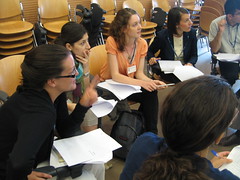 In his seminal work, Agenda for Peace, former UN Secretary-General, Boutros Boutros-Ghali states that, “the concept of peace is easy to grasp” while that of security “is more complex”. Boutros-Ghali suggests that everyone already knows what comprises peace, so he doesn’t have to explain it.
In his seminal work, Agenda for Peace, former UN Secretary-General, Boutros Boutros-Ghali states that, “the concept of peace is easy to grasp” while that of security “is more complex”. Boutros-Ghali suggests that everyone already knows what comprises peace, so he doesn’t have to explain it.
Our speakers today challenged this assertion, confronting us with questions such as ‘what is peace?’, ‘how do we measure it?’, and ‘when is it present?’. In some ways, the topic of this week, Conflict Resolution and International Justice, is the most highly charged topic of this Symposium: while it is clear that violent conflict should be prevented or managed in a way that stops people from being killed, building a positive peace (where violence doesn’t occur again) rather than just a negative peace (where violence isn’t happening now) after violent conflict is a highly politicised process with major and long-lasting effects on the populations that it targets.
 Our first speaker, Ambassador Alvaro de Soto problematised the idea of peace by explaining how the norm of ‘post-conflict peacebuilding’ developed in the UN at the end of the Cold War. Growing from the lessons learnt in the late 1980s and early 1990s, Boutros-Ghali first articulated it as a policy concept within the UN in Agenda for Peace in 1992, aiming to both to stop violence and prevent it from reoccurring. Yet, this has remained a difficult task to implement, not least because of a lack of unified political will in the international community, and clear yardsticks of success. Additionally, the transitions from war to peace are usually multi-pronged, with concurrent societal transitions from war economies to market economies, from chaos to democracy, from instability to security, and transitions within people themselves, from combatant to citizen, from victim to voter, from hatred to forgiveness.
Our first speaker, Ambassador Alvaro de Soto problematised the idea of peace by explaining how the norm of ‘post-conflict peacebuilding’ developed in the UN at the end of the Cold War. Growing from the lessons learnt in the late 1980s and early 1990s, Boutros-Ghali first articulated it as a policy concept within the UN in Agenda for Peace in 1992, aiming to both to stop violence and prevent it from reoccurring. Yet, this has remained a difficult task to implement, not least because of a lack of unified political will in the international community, and clear yardsticks of success. Additionally, the transitions from war to peace are usually multi-pronged, with concurrent societal transitions from war economies to market economies, from chaos to democracy, from instability to security, and transitions within people themselves, from combatant to citizen, from victim to voter, from hatred to forgiveness.
 Our second speaker, John McNamara, described more about the specific complexities of implementing postconflictpeacebuilding. Speaking of his own experience in the U.S. State Department’s Office of the Coordinator for Reconstruction and Stabilization, he highlighted the difficulty of running a process conceived by external actors but implemented locally. In particular, he demonstrated the tension between responding to the uniqueness of each conflict while working from a blue-print that allows for immediate deployment of civilian forces and is coherent enough for policy-makers to make decisions quickly. In spite of this need for streamlining, his PowerPoint slides featured complex matrixes, diagrams and conflict maps that demonstrated all too clearly the interdependency of many parts of post-conflict peacebuilding processes. Responding to some of the cohort’s concerns about whether these activities were possible or would resolve the conflict, he told us of a Haitian proverb: “beyond the mountains lie more mountains”.
Our second speaker, John McNamara, described more about the specific complexities of implementing postconflictpeacebuilding. Speaking of his own experience in the U.S. State Department’s Office of the Coordinator for Reconstruction and Stabilization, he highlighted the difficulty of running a process conceived by external actors but implemented locally. In particular, he demonstrated the tension between responding to the uniqueness of each conflict while working from a blue-print that allows for immediate deployment of civilian forces and is coherent enough for policy-makers to make decisions quickly. In spite of this need for streamlining, his PowerPoint slides featured complex matrixes, diagrams and conflict maps that demonstrated all too clearly the interdependency of many parts of post-conflict peacebuilding processes. Responding to some of the cohort’s concerns about whether these activities were possible or would resolve the conflict, he told us of a Haitian proverb: “beyond the mountains lie more mountains”.
I am sorry to disagree with Boutros-Ghali: but I think peace is far from “easy to grasp”. Instead, peace depends on a complex web of other conditions, and the lack of clear answers means we have to prioritise what we value and can do, rather than knowing what may make the most difference. Today’s presentations showed us that the international community still has long distances to traverse, and the mountains that we, in this class, face in our future work may be endless. Yet, the hope for the future is also present in this group: if there are mountains to cross, then this group can do it.
Rachel Hart, Australia

